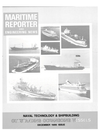
General Electric Expands LM Family Of Aeroderivative Gas Turbines For Marine Service
—Free Literature O f f e r e d— With its first installation in the GTS Admiral Wm. M. Callaghan, a RO/RO cargo ship in 1969, the General Electric LM2500 marine gas turbine has been a favorite selection for naval ship propulsion.
Powering ships with displacements ranging from just over 200 tons to the planned 53,000-ton AOE-6 combat support ships, the LM2500 has been selected by 15 international navies, as well as the U.S. Navy itself. More than 500 LM2500s will be fitted on 223 ships in 28 navy ship programs.
Recently, the U.S. Navy selected the LM2500 to power the new Arleigh Burke Class destroyers (DDG- 51), which will be one of the Navy's major surface combatant ships. For these destroyers, the LM2500 will be uprated to 26,250 hp and have single shank high-pressure turbine blades. The Navy selected the LM2500 because its more than 1.5- million hours of reliable service, and current and future programs incorporating the LM2500 will ensure production until 2030.
This year, the smaller LM500, rated at 6,000 hp, was selected by the Royal Danish Navy to power its new Standard Flex 300 ships. The installation of the LM500s in the Standard Flex 300s not only marks the company's first installation in a mine countermeasure ship, but also in a naval combatant as well. It is also said to be the first LM engine in a combined diesel and gas turbine (CODAG) propulsion system. The power turbine of the LM500 will drive a fixed-pitch propeller directly through a reduction gear, saving weight by eliminating an enginemounted epicyclic gearbox. Some of the design features that make the LM500 attractive to marine and industrial operators include: the highest efficiency in its power class; the use of corrosion-resistant materials; borescope inspection ports for reduced maintenance; a variable stator compressor for good stall margin and an operational envelope from -54°C to 54°C; and reliability.
In addition to the Standard Flex 300, the LM500 is said to be ideal for patrol boats in the 100- to 300- ton range, and is excellent for aircushion vehicles, fast-attack craft and vessels such as the Italian Navy Spaviera Class hydrofoil, where higher power density, weight and size are at a premium.
In the fall of this year, the LM1600 simple cycle gas generator was added to the expanding General Electric LM family of advanced aeroderivative gas turbines. This new entry was derived from the highly respected F404 aircraft engine which powers the Navy's F/A- 18.
The LM1600's introductory rating is 19,000 isentropic gas hp with an overall gas generator thermal efficiency of 40.2 percent. Incorporating the F404's simple design and reliability, the LM1600 features one of the best fuel efficiencies in its power class. Its extremely high power density enables the engine to produce the same power output with an airflow of 100 pounds per second (pps) as did earlier engines with airflows of 125 to 145 pps. The fuelefficient LM1600's size is said to make it ideal for industrial mechanical drive, power generation and ship propulsion.
The LM1600 Intercooled Regenerative engine is being studied in a development program funded by the U.S. Navy as a major candidate for the next generation naval engine.
Requirements for this engine include delivery of 24,000 bhp at 100°F, while consuming 30 percent less fuel and fitting into the same space as the current LM2500s.
One of the direct results of this development will be a gas turbine engine which can effectively match diesel fuel consumption over a wide range of power output. This would clearly be of interest to both naval and commercial ship designers and builders in the mid- to late 1990s.
For free color literature containing detailed information about General Electric's LM family of advanced marine gas turbines, Circle 97 on Reader Service Card
Read General Electric Expands LM Family Of Aeroderivative Gas Turbines For Marine Service in Pdf, Flash or Html5 edition of December 1986 Maritime Reporter
Other stories from December 1986 issue
Content
- $40-Million Containership To Be Built By Samsung page: 4
- Frederikshavn Werft Offers Color 20-Page RO/RO Ship Brochure page: 5
- Daniel A. Marangiello Joins ANADAC, Inc. page: 5
- New Offshore Committee Formed By SNAME— McClure Named Chairman page: 6
- Cost-Saving Numeric Control Service Offered By Maritime Design page: 6
- APL To Build Five New Ships page: 7
- Todd Signs Agreement With Australian Shipbuilder For Technology Transfer page: 7
- Volvo Penta Constructing New Production Facility page: 8
- Isle Of Man Ship Registry Growing page: 8
- James J. Henry page: 8
- OUTSTANDING OCEANGOING SHIPS OF 1986 page: 10
- THEODORE ROOSEVELT (CVN-71) COMMISSIONED page: 31
- Moss Point Marine Awarded $40.7-Million Navy Contract To Build Four LSVs page: 32
- N e w Book Accounts Histories of 500 Ships Built By Newport News page: 33
- Safety Coating Developed For Navy Is Commercially A v a i l a b l e For Marine Use page: 33
- U.S. NAVY SHIP PROCUREMENT THE FY 87 NAVY SHIPBUILDING AND CONVERSION BUDGET page: 34
- Major Navy Contracts page: 37
- $240-Million Modernization Program Announced For Portsmouth Navy Shipyard page: 38
- Sparrows Point Eligible For All Navy Contracts page: 38
- NCEL Develops New Multi-Function Tool For Naval Diver Use page: 38
- $1-Million Navy Contract To Airflow Company For Dockside A / C Units page: 38
- New Jam-Proof High-Speed Data Link Sought By Navy page: 38
- First Honeywell Hydrostar Plus System Sold To Navy page: 39
- Marine Machinery Association Discusses Quality Control With Navy Officials page: 42
- Hospital Ship USNS Mercy Dedicated At NASSCO In San Diego page: 42
- Tacoma Boatbuilding Launches Tenth T-AGOS For Navy page: 45
- Aegis Missile Cruiser xLeyte Gulf' Christened At Ingalls Shipbuilding page: 46
- Over Half Of Navy's Procurement Dollars Awarded Competitively page: 46
- Westinghouse Incorporates Proven GPC-1500 Controller Into C 0 / 0 2 Trim Package page: 47
- New Brochure Emphasizes Products & Services For Defense/Marine Industry page: 50
- GE's LM2500 Engines To Power Portuguese Frigates page: 50
- Falk To Market Masson Marine Drives page: 53
- NAVIGATION & COMMUNICATIONS EQUIPMENT page: 54
- New Corrosion-Resistant Monel Hose From Cajon page: 62
- Cunard Line To Spend $130 Million To Overhaul The Queen Elizabeth 2 page: 63
- Lubriquip Offers Literature On Automatic Centralized Lubrication Systems page: 63
- Koch-Ellis Provides Service To Meet Pollution Prevention Standards Of MARPOL 73/78 page: 63
- Mobil Oil Introduces Six Hydraulic Fluids page: 64
- Textron Marine Appoints L.N. Hairston Executive Director Of Marketing page: 64
- New Ship Repair Facility At Port Of Portland page: 65
- 300-Page Fishing Vessel Safety Manual Published page: 65
- TDI Catalog Now Includes 100-MM Chart Recorders page: 65
- Rockment To Supply Rockwool TNF Panel System For Cruise Liner page: 65
- General Electric Expands LM Family Of Aeroderivative Gas Turbines For Marine Service page: 66
- Magnavox Offers Dual Telephones With Satcom Terminals page: 69
- Bostik Introduces New Marine Grade Anti-Seize Compound page: 73
- Multipurpose Cargo Ship Launched At Jansen Werft Yard page: 73
- MacGregor-Navire System Centerpiece At Dartford 'Miniport' page: 74
- New Jamesbury Spring Actuator Is Compact, Corrosion-Resistant, Economical page: 74
- National Crane Offers Free Literature On Cranes For Marine Applications page: 79
- Farrell Says New Waterways Bill Is 'Major Step Forward' Toward Rebuilding Nation's Infrastructure page: 79
- St. Augustine Trawlers Delivers DeJong & Lebet-Designed Excursion/Diving/Cruise Ship page: 79


